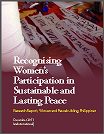Feminist Perspectives on Media
One of the most significant breakthroughs in the last century was the globalisation of the feminist agenda. In this connection, the event that caught the maximum world attention was the "Fourth World Conference on Women" held in Beijing in 1995. The Conference established a strong international consensus to promote women's and girls' rights as the key to development everywhere. In many ways, it forced several government leaders to revisit their national landscape for women's concerns. It also recognised the critical role that media plays in the portrayal of the image of women in society.
The "Beijing Platform for Action (BPFA)" specified plans and strategies that would make it possible for the advances in information technology to facilitate the empowerment and development of women all around the world. It noted the continuous projecting of negative and degrading images of women in media-electronic, print, visual and audio-and called for action so that the media would be a part of the scenario of change.
Thus, the women's movement and the use of media got further impetus after the Beijing Conference in 1995. Many women's organisations then began to voice their concerns against the negative portrayal of women as a commodity and as second-class citizens through both private- and government-controlled print and electronic media, and the need for encouraging women to join the profession.
Drawing inspiration from the Beijing Conference, the Women's Media Forum, called "Sancharika Samuha" was established in Nepal in April 1996. The objective of the Forum is twofold: first, to empower the women working within the media, and second, to use the potential of the media to promote and advocate for women's issues and rights. The Forum faced a lot of hardship during the initial stage when it was trying to gain recognition from government and professional media institutions that were not too eager to see a secular women's media group and would have preferred that the Forum functions as a subwing under the bigger political media associations. However, today (almost nine years after its inception) the Forum has been successful in gaining an equal voice in national and regional forums. It has been relevantly successful in promoting the issue of gender and media through advocacy, training, public outreach campaigns, and use of mainstream and alternative media. Last year, the Forum, in collaboration with the South Asia Free Media Association (SAFMA), hosted the first "South Asia Regional Workshop on Gender and Media".
This paper is, on a major part, based on some of the key perspectives on media that are drawn from the regional workshop and the experiences of Sancharika Samuha in working in the sector of gender and media.
Traditionally, the media world has been male-dominated globally as well as nationally. Men design and define media policies, priorities, and agendas, including how women are portrayed and presented. Most often, it is men who make decisions about hiring staff. The ratio of male-female workers in the media is heavily imbalanced in favour of men. It is no wonder then that the media is biased against women in many areas. This bias affects images of women in the media, and, in turn, has a negative effect on women's development in a society.
In examining gender patterns in South Asia, we need to analyse the participation and position of women in the media, and the impact of these positions on women's development. By this, we mean the women's right to participate in public debates and to have their views heard, and the right to see themselves portrayed in the media in ways that accurately represent the complexities of their lives.
Portrayal
Up to now, the leadership paradigm has been generally based on male models, as men tend to dominate decision-making positions all over the world. I think that the media in our region is very much influenced by this trend. The media fails to understand that there is an enormous range of visions in this world, and how differently people practice and perceive leadership to bring about fundamental positive changes. Most journalists, even female journalists, tend to think that only the perception of men is important when dealing with issues like governance, politics, decision-making in civil service, and many others. Women have made significant strides in many areas but the media has been slow to recognise these gains and has not sufficiently search out the terrain to be able to find women in new roles.
With increased voices and protests from active women's groups, some of media's negative portrayal and representation of women have become quite subtle in the last few years. However, it is still rare that the media presents women as contributors to the development process or as professionals in their own field. The patriarchal culture of societies is very much reflected in various media reports and presentations. The lack of a truly gender-sensitive appreciation and analysis of women's issues by both men and women in media has allowed exploitative and derogatory images of women in media to continue. These images of women are deeply rooted in traditional social practices and interpretation that help the media in constructing these representations.
In Pakistan, there is a marked increase in women's magazines that are home-, kitchen-, and fashion-based. These magazines focus heavily on the domestic side of women, trying to prove that every woman needs to be a perfect cook, a tailor, and a housekeeper, and also be beautiful. Women's abilities as equal partners in development are lost between cooking oils and fairness creams. This trend is dangerous especially because the clientele is across the board. The same trend can be witnessed in the ever-increasing number of teleplays that focus on women being the focal point of domestic peace and harmony in most of South Asian countries.
In Sri Lanka, most of the daily newspapers have discreetly dropped the inclusion of women's pages. However, if one looks at the images of women that appear repeatedly and in greatest numbers in newspapers, by no means does this indicate that sexism has been eliminated. In the absence of positive or empowering images of women elsewhere, the overall effect of this preponderance of fashion-and-society images is to associate women with social frippery. Hence, the overall impact is sexist.
In India, cricket news occupies nearly 20% more space than women's issues. Female presence is more through advertisements, news of crime, and social events. Women's representation has moved beyond female images of the family and home to personal care, as dictated by the market agenda in a predominant patriarchy. The subtle stereotyping is more insidious as it is relatively more invisible but, nonetheless, demeaning and patronising.
Participation (Gender Balance)
The convergence of new media technologies and influx of private media organisations in the last decade has increased the number of women working in both print and electronic media. However, women have not gained parity with men in terms of participation and decision-making. Top management is still entirely male-dominated and patriarchal, with only a negligible number of women holding senior positions. Although women have become more visible, particularly in radio and television as presenters, announcers, and reporters, the gender division of labour is highly pronounced in the production, creative and technical departments, which are male-dominated. The many, upcoming private television and radio channels have no doubt employed many young women as reporters and DJs (disc jockeys), but this is where it all stops. Women are also largely absent in official commissions, boards, or committees created for formulating policies or monitoring the media.
Thus, very few women journalists, whether from print or electronic media, have made it to the top ladder. For example, in the 54-year history of Pakistan, no woman has ever been an editor of an Urdu newspaper, and only one woman became an editor of an English daily. The state-controlled Pakistan Television Corporation has had one woman reaching the top position of managing director, and another woman who held the position of the director of programmes. But the state-owned Pakistan Broadcasting Corporation has never had a woman as director-general. In Nepal, no woman has ever been an editor of a Nepali or English daily, although there are a few women editors of Nepali weeklies and magazines. The electronic media is still worse, but recently one woman was promoted as chief editor of the state-owned television. In Sri Lanka, which is expected to be more progressive, there is something like a 50-50 balance of men and women at the level of reporters and sub-editors. But there is not a single woman editor in the mainstream press. In most of the Bangladesh dailies, women are working either in the feature sections or in the desks. In India, too, a look at the disaggregated data reveals that women as broadcasters and on desk jobs have a higher representation than as correspondents.
Not surprisingly, women are underrepresented at the higher management and decision-making levels in the mainstream press throughout the region. Thus, the general newsroom culture continues to be overwhelmingly male chauvinist. Women's exclusion from and by media systems leads to apathetic attitudes to women.
Division of Labour
Where earlier it was almost impossible to find a woman reporting on politics and economy, now a few young women have emerged as reporters on such hard core issues as well. However, the gender division of labour is still very much evident in the way coverage of stories is assigned in most media organisations. Women still predominantly tend to be assigned to "soft issues" such as culture, art, and lifestyle, while men are assigned to political and economic stories that are considered more as "real issues." Denying women the right to cover hard news discourages these women from pursuing careers in journalism. Media, instead of eliminating the problems, ensures security of its female members by keeping them away from competitive beats. The women remain obviously isolated from availing themselves of corresponding opportunity and thus, cannot grow into the profession.
The number of women entering media is increasing. But stereotyped attitudes, sexual harassment, unfair treatment in assignments and promotions, traditional gender hierarchies, and lack of support mechanisms for working women are obstacles that hinder women from joining the media or assuming decision-making positions. The late working hours required in journalism still carry a social stigma for women. In addition, media offices fail to provide a congenial atmosphere for female journalists. Although there has been no authentic research to justify the fact, many have felt that the widespread cases of sexual harassment within media organisations have been as a means to control and exclude women from occupying key positions in the industry.
Most media organisations still harbour the idea that women have less working ability, are weak, and may not be able to carry out the responsibilities that are assigned to them. So these women are discouraged to take up challenging tasks and assignments resulting in their lack of confidence. Women are, thus, typecast in traditional feminine roles that they are still playing and arguing about today.
Content
There has been little progress in the transformation of media content since 1995. The "Global Media Monitoring Project" that year showed that 17% of news sources were women. By 2000, this figure increased, but to a mere 18%. About half of these news sources were related to sex, prostitution, glamour, entertainment, and crime. Certain categories of women such as the poor, disabled, older women, or those belonging to ethnic minorities were almost invisible. At the same time, some other categories of women, especially the young, were more visible as their sexualised images were exploited in order to promote the commercial interests of media and other enterprises.
In Nepal in the past few years, there has been a comparatively improved and increased reportage of issues related to women in the media, particularly in the print. News related to women, although still marginal, has started to occasionally occupy important slots like the editorial, feature news, front-page news, and many others. However, women's visibility in the news is still dominated by sensational stories of glamour, sex, domestic violence, and other forms of violence. Stories like women coping with adversity or building their lives are largely missing. Also missing are the changing and professional roles of women and their contribution to nation development. Freedom of expression implies that women's voices as well as men's deserve to be heard. However, what we see and hear in the media represents a severely limited range of voices. Many studies have established that when women appear in the news, they are mostly projected as passive victims or passive reactors to public events in news media. They hardly appear as speakers or participants in public event. This calls into question the extent to which women's rights and freedom of expression are currently respected in media output.
Although the media carries out coverage of women's issues, the aspects that promote and create awareness for gender empowerment among the citizens are tranquil. In fact, the problems are sometimes further perpetuated by mainstream (male stream) media with portrayals that have only served to reinforce, rather than challenge, men's suppression of women. For instance, the arrival of new commercial cable and satellite television channels as well as the privatisation of old state-run media have led to a more market-oriented content in several countries of the region. This development, in turn, has introduced new tensions and conflicts in the representation of women. Similarly, with media structures and hierarchies still dominated by men, content continues to reflect a masculine vision of the world and of what is important. As a result, issues that are particularly crucial to women's lives are low in the scale of what is regarded as newsworthy. At some time, media simply concentrates on events-coverage, in the process sidetracking other pressing needs. For example, such issues like the annual "International Women's Day"get a natural highlight in the media, but only during the observation of such specific events.
Apart from few random concessions to the subject of gender, it is evident that issues relating to women in all their complexity are not sufficiently explored in the media. Gender-related issues need to be dealt with more thoroughly in the general news and feature pages of mainstream newspapers, and not merely in columns or pages dedicated to women. Most women's issues have something to do with patriarchal attitudes or behaviour, and problems can be traced to male-dominated bureaucracies and environments of one kind or another.
Media Advocacy
Despite the dismal picture, several successful media advocacy initiatives have helped in bringing about policy reforms. The "Women's Feature Service" is one such example. In Nepal, too, we have been putting out a monthly "Sancharika Feature Service" that deals on issues related to women, with the objective of mainstreaming gender issues. The articles from the feature service are given considerable importance by the daily and weekly papers. Publications comprising articles from the feature service are being used as educational as well as advocacy tool.
Some interventions in creating alternative media spaces for the expression of women's perspectives have been successful in bringing about policy reforms. The media campaigns conducted in Nepal helped a lot in the promulgation of legislation on equal property rights for women and abortion rights. After a launch of a video programme featuring different forms of violence against women, the government minister, who was then present at the launch, publicly committed to appoint the first woman representative in the Planning Commission. The Cabinet did so after 18 days. Also, after a two-week intensive media campaign targeted to empower migrant women workers, the government came up with a 12-point programme agenda, which included issues raised by the media. The government also lifted the ban on women to go to Gulf countries for employment.
The web has also expanded the women's world, primarily in terms of creating strong online communities. Sancharika Samuha has made efforts to act as a bridge through its website programme (Mahilaweb) to unconnected groups in the community, by either packaging information and feeding it on the web, or repackaging information found online and sharing it through other communications channels and in local languages. Although there have been some public service and community media organisations that tend to recognise the need to reflect diversity and to serve the public interest, these organisations are also under threat from the intensification of market-oriented media systems, or their sustainability is in question due to their high dependability on donor funding.
Policies
Almost all countries of the region have a national plan of action based on the strategic objectives of the BPFA. These plans have specified actions to promote gender and media, and how to utilise the media for advocacy and policy. But no significant effort to implement these policies has been observed. In most of the countries, media policies, like all other state policies, have always been determined by the party or agency in power. Thus, states have failed to come up with a consistent media policy. The media policies, from time to time, vary from mild liberalism to rigid orthodoxy.
Very few communication policies take gender issues into consideration. But the absence of gender-sensitive policy is generally unnoticed by policymakers, themselves. A fundamental concern is, therefore, the need to build awareness among decision-makers and policymakers about the significance of gender and its impact, and about the need for a gender dimension within policy frameworks. Parallel to this is the need for more women in decision-making positions within the policymaking process.
In the absence of defined and institutionalised policies, the procedures and mechanisms guided by gender-just concerns, and the messages conveyed fall in the realm of individual attribution of meaning. In India, the lack of formalised structure allows the media to selectively appropriate and represent gender issues contextually in conjunction with the dominant socio-political norms. Thus, gender representation in the media is open to the influence of competing tendencies, be it the market, cultural capital, communalism, electoral politics, or women's empowerment articulations.
The occasional attention on women's issues suffers due to the absence and sustainability of appropriate policy guideline. In order for the media to reflect gender rights in a sustained and coherent manner, gender-sensitive guidelines and mechanisms have to be evolved. The media must respond to historical and socio-cultural forms of gender differentiation, taking into consideration Asian multiculturalism and its associated peculiarities, and recognition of gender differences and women's special interests. While adherence to principals of equality can be lauded, the procedures and systems that evolved and aimed at promoting empowerment must be screened through assumption of gender rights. Gender diversity within the media is an effective strategy only when supported by gender-sensitivity, competitive gender capacities, and institutionalisation of gender-just norms.
Enabling policies and mechanisms assume particular importance at a time when control of mass media networks-including radio, television, films, newspapers, magazines, cable, satellite, internet and telecommunications -is increasingly concentrated in the hands of a few media conglomerates, many of which are resource-rich and powerful transnational entities. There is a need for research that analyses gender aspects of media content and media performance in relation to existing legislation, policies, and codes-with a view to making recommendations for change or for the development of new policy that take into account gender considerations.
Challenges Posed by ICT -Key Concerns
The growth of new information and communication technology (ICT) has many conflicting facets. On one hand, the electronic highway system created by satellite, cable, and the internet provide existing media giants with vast global markets for their information and entertainment products, and create a new communication and cultural environment. This development introduces major new concerns in relation to media freedom. These concerns have been a primary means for corporate expansion globally, built upon existing unequal terms to trade relations and upon persistent socio-economic inequalities within societies. On the other hand, the arrival of digital media technologies provides the means for individuals, small groups, and previously marginalised communities to express their views. Many women NGOs say that they have benefited from this by: gaining more visibility through websites, having access to donor assistance, and being able to get information, especially on international and regional activities relating to the women's movement. There also have been increased opportunities for wider dissemination of women-generated news through low-cost newsletters or, in some cases, short-wave radio. In that sense, the new technologies offer potentially important new audiences, access to a wider range of sources of material, and rapid means of information exchange on issue of professional or political concern.
Despite the unprecedented gains of women from ICT, there are more women on the other side of the digital divide without the know-how or access to take benefit from this technology. Access to this new medium is particularly difficult for women in poorer and less urbanised areas where telecommunications infrastructures are poor and unaffordable. Lack of skills, literacy, education, training, technophobia, language, time, cost, geographical location of facilities, and social and cultural norms also serve as major deterrents. A World Bank report has noted that there is evidence that in high-income countries, skilled workers have benefited the most from ICT. In fact, the internet has the potential to be a stronger force for generating inequality, as compared to earlier communications technologies, because it is expensive, requires a high level of education and skill to operate, uses languages not widely spoken by the poor, and needs skilled personnel, electricity, and a critical mass of users to make it sustainable (World Bank 2002). In the context of these obstacles, the barriers against women in rural communities using ICT are likely to be even more pronounced.
There is also a growing concern that the information revolution is creating a new world communications order that is being shaped and dominated by big transnational corporations that care more about profit than public service. What is worse is that it has opened up new ways of exploitation, and has exposed women and girls to new risks and vulnerabilities. The internet, for example, has been instrumental in encouraging traffickers and pedophiles to establish interest-networks that lure young women and girls.
Fears have been expressed that the commercialisation of media could lead to the marginalisation, even death of small, indigenous media outfits that cater to voiceless sectors, including women. While ICT is assumed to enhance the work of professionals employed in traditional media, here, too, the notorious digital divide is likely to be compounded by a gender divide. That is, unless special efforts are made to equip women in the media to take advantage of the opportunities made available by technology.
Furthermore, the patterns of gender-segregation that are well-known in the established media industries are worse in the field of ICT. Women are virtually absent form senior decision-making and politically influential positions in the ICT sector. Therefore, women have benefited less from, and have been disadvantaged more by technological advances. Women, thus, need to be actively involved in the definition, design and development of new technologies. Otherwise, the information revolution will completely bypass women or continue to produce adverse effect on their lives. Relevant and useful resources about women will not appear unless women work to create them.
In spite of the concerns, it has to be acknowledged that ICT does have immense potential to transform unequal power relations. However, this recognition has to include an awareness of the limits of ICT- and that in and of itself, ICT cannot create gender equality, or end poverty but that it can be a tool for social action and positive social change.
ICT must be a part of a wider campaign for a more just world order. If ICT offers a more effective way of generating income, securing education and training, and getting critical information related to health and well-being, women will find time to incorporate ICT into their lives. ICT can then facilitate life-long learning for women if the right policies and partnerships are in place.
References
Women in Action 2000, Women and Media for Social Change: Communications Initiatives Worldwide.
Sancharika Samuha/UNIFEM 2003, Foreign Employment for Women: Challenges and Opportunities.
Sancharika Samuha/SAFMA 2004, Regional Workshop: Gender and Media in South Asia.
Expert Group Meeting on Planning for the Regional Beijing+10 2004, Background Document
Adama Samassekou 2003, Proposal of an Orientation Document for PrepCom-2, Information and Communication for All.
Joanne Sandler UNIFEM 2002, Statement made to WSIS Prep Com in Geneva.
DAW, Department of Economic and Social Affairs 2002, Report of the Expert Group Meeting, Participation and Access of Women to the Media, and the Impact of Media on and its Use as an Instrument and Empowerment of Women
Report of the Secretary General 2003, CSW 47th Session, Participation and Access of Women to the Media, and the Impact of Media on and its Use as an Instrument and Empowerment of Women.
Rosalind Gill 2003, written statement submitted to CSW 47th Session, Participation and Access of Women to the Media, and the Impact of Media on and its Use as an Instrument and Empowerment of Women
Chat Garcia Ramilo 2003, written statement submitted to CSW 47th Session, Participation and Access of Women to the Media, and the Impact of Media on and its Use as an Instrument and Empowerment of Women
FAO ICTs: Gender and Development and Rural Women: February 2003.
Know-How GEM 2002, An African Gender and Media (GEM) Publication





 The
The 
 Isis Resource Center holds one of the largest feminist collections of materials in the Global South. With 40 years of publication experience, Isis holds a vast collection.
Isis Resource Center holds one of the largest feminist collections of materials in the Global South. With 40 years of publication experience, Isis holds a vast collection.